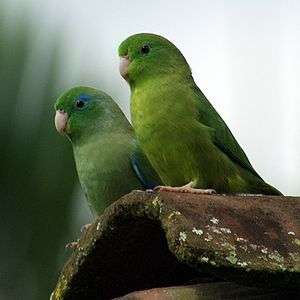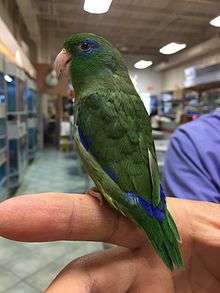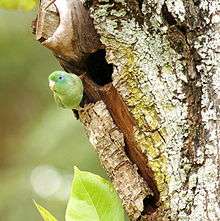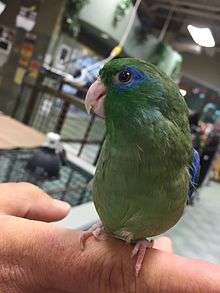Spectacled parrotlet
| Spectacled parrotlet | |
|---|---|
 | |
| A pair in Colombia (male on left and female on right) | |
| Scientific classification | |
| Kingdom: | Animalia |
| Phylum: | Chordata |
| Class: | Aves |
| Order: | Psittaciformes |
| Superfamily: | Psittacoidea |
| Family: | Psittacidae |
| Subfamily: | Arinae |
| Genus: | Forpus |
| Species: | F. conspicillatus |
| Binomial name | |
| Forpus conspicillatus (Lafresnaye, 1848) | |
The spectacled parrotlet (Forpus conspicillatus) is a species of parrot in the family Psittacidae and is one of the smallest new world parrot species. Spectacled parrotlets are endemic to Middle and South America, including Northern and Central Colombia, Venezuela, and Eastern Panama.
Taxonomy
The family of parrotlets includes Blue-Winged, Green-Rumped, Mexican, Scalter’s, Spectacled and Yellow-Faced parrotlets. Based on DNA evidence, the genus Forpus is most closely related to the genus Amazona, which includes amazon parrots.
Subspecies[2]
Forpus conspicillatus caucae - On the male, the blue is paler and less violet in rump and on upper and under wing coverts, slightly bigger beak. Females look identical to those of the nominate species. This subspecies is found in the Western Andes, and the upper Patia and Dagua Valley as well as the Cauca Valley in Colombia. It is considered an endangered species.
Forpus conspicillatus metae - On the male, the underparts are a brighter, yellowish green colour, the throat and cheeks and bend of the wing may also appear yellowish. The head is a brighter green, and blue contour around eye is reduced to mainly the posterior part of feathers surrounding the eye. Can be found in Eastern Andes, and from Meta River, in Central Colombia all the way into Western Venezuela.
Description
Spectacled parrotlets are sexually dimorphic and can be sexed around three weeks of age. The male has violet-blue plumage under the wings and on rump. Males will also develop contour of blue around eyes after their first moult (5–7 months of age).
Females are completely green with a slightly brighter green head than body.
Weighing only 30 grams and growing up to 12 cm, spectacled parrotlets are the smallest parrotlet to exist.
Babies are born with a bright pink beak that changes to a beige colour as they age. They have a large and strong bill used for climbing and cracking open seeds and nuts, digging, foraging and preening.

Distribution and habitat
Spectacled parrotlets are endemic to Middle and South America, including Northern and Central Colombia, Venezuela, and Eastern Panama. (Subspecies can be found in specific regions of Colombia and Venezuela, see above). Natural habitats are subtropical or tropical dry forests, subtropical or tropical moist lowland forests, and heavily degraded former forest.
Couples will nest in tree holes of the Amazon Rainforest, or take over abandoned tree hole nests that other species have made.
Green and blue colouring helps them camouflage with the tropical trees of amazon. Though colour mutations such as the yellow pied mutation may occur in captivity, they are rare in wild due to the fact that a brighter colour compromises ability to hide from predators.[3]
Behaviour
Feeding
In the wild, spectacled parrotlets feed on seeds, nuts, leaves, berries, cactus, Tamarindus and other fruits. Occasionally they may feed on small insects. Spectacled Parrotlets live in small flocks, but can be seen in large flocks of up to 100 on clay mountains drinking runoff [4] or eating clay.[5] These clay licks provide a good source of minerals such as calcium to egg laying females.
Reproduction

The bright colour of the male and specific mating calls attract the female to the male parrotlet. Pairs will mate and construct or colonize a nest in order to successfully reproduce.
Spectacled parrotlets nest in closed in tree holes. Often they will make use of abandoned tree hole or clay mountain nests. The female incubates eggs,[6] while the male assumes the role of guarding the nest and feeding the female and chicks once they are hatched. Spectacled parrots are monogamous and some pairs may even mate for life.
Once the female lays one egg she will lay another every two days until clutch size is reached.
Typically, a couple will hatch 4-6 eggs per clutch after an 18 day incubation.
Babies will be fledging by about five weeks and siblings will keep in close contact with one another for a few weeks post fledging.[7] Birds from the same clutch use specific calls and continue to feed each other and play until they are self-sufficient and mature.
Vocalizations

Spectacled Parrotlets are able to differentiate between social companions and adapt their calls to mimic the call of the bird they are communicating with. Specific calls are used when communicating with mates, offspring, parents, etc.[8]
Calls can range from tweeting, chirping or buzzing sounds depending on the information being relayed.
In aviculture, pet spectacled parrotlets can learn to mimic their owners.[9] Males are known to be better mimickers than females due to the instinctive nature of calling to attract a female in the wild.[10]
Aviculture
In recent years, spectacled parrotlets have become increasingly popular pets. Parrotlets can be held in captivity as breeding pairs or as a social companion.
Breeding pairs
Breeding pairs do not make good companions, as they cannot be handled if you want to successfully breed them. The pair require a closed nest box, mimicing a tree hole nest in the wild, in order to reproduce.
Hand-fed birds
Hand-fed parrotlets are much more popular in aviculture. Babies are taken from nest at a few weeks old and fed a nutritionally rich pablum like mash, rich in protein, fats and minerals necessary for development. Chicks are fed using a syringe starting at three to four times per day. They consume two to four CCs of mash per feeding.
Feeding frequency and volume diminishes as the bird develops.[11] By the age of four to six weeks, the Parrotlet will have transitioned to mixed grains or pellets and eat enough on its own to sustain itself. At this point the bird no longer needs to be hand-fed. Because the bird was habitually handled, they remain sociable and enjoy spending time out of the cage with their owners. If, however, after weaning, the bird is not regularly taken out of the cage, they may revert back to a wild, nervous or aggressive temperament.
Spectacled parrotlets should be provided with a cage roughly 24’’ by 24’’ by 18’’.[12] Perches in the cage should be of different sizes and textures, as branches would be in the wild to encourage nail filing and exercising of feet. Toys should be provided, especially foraging toys to encourage active playing and chewing to exercise the beak.
Often, owners of Spectacled parrotlets will clip the flight feathers as a safety precaution for the bird. Typically, the first six primaries are cut. These feathers grow back when the bird moults (roughly twice a year). Nails should be clipped every four months to prevent overgrowth and ensure comfortable perching.
Domesticated parrotlets diet can consist of mixed grains or pellets. Mixed grain diets usually consist of white millet, sunflower seeds and a variety of other seeds. Pellets are often the preferred diet due to the fact that they are more nutritionally wholesome. With a pellet diet, the bird cannot pick and choose what it eats. Pellet diets are often enriched with proteins and minerals such as calcium to ensure the bird is getting the necessary minerals that would naturally obtain from its diet in the wild.
External links
- World Parrot Trust Parrot Encyclopedia - Species Profile
References
- ↑ BirdLife International (2012). "Forpus conspicillatus". IUCN Red List of Threatened Species. Version 2013.2. International Union for Conservation of Nature.
- ↑ "Spectacled Parrotlet (Forpus conspicillatus)". www.beautyofbirds.com. Retrieved 2016-10-13.
- ↑ Tarwater, Corey E.; Beissinger, Steven R. (2012-11-01). "Dispersal polymorphisms from natal phenotype–environment interactions have carry-over effects on lifetime reproductive success of a tropical parrot". Ecology Letters. 15 (11): 1218–1229. ISSN 1461-0248. doi:10.1111/j.1461-0248.2012.01843.x.
- ↑ "Parrotlets | ParrotFeather.com". parrotfeather.com. Retrieved 2016-10-13.
- ↑ ], PINT [ www.pint.com. "Parrotlets". www.petuniversity.com. Retrieved 2016-10-13.
- ↑ Kattan, Gustavo H.; Gómez, Natalia (1992-01-01). "Body Temperature of Spectacled Parrotlet Nestlings in Relation to Body Mass and Brood Size". The Condor. 94 (1): 280–282. JSTOR 1368818. doi:10.2307/1368818.
- ↑ Wanker, Ralf; Apcin, Jasmin; Jennerjahn, Bert; Waibel, Birte. "Discrimination of different social companions in spectacled parrotlets (Forpus conspicillatus): evidence for individual vocal recognition". Behavioral Ecology and Sociobiology. 43 (3): 197–202. ISSN 0340-5443. doi:10.1007/s002650050481.
- ↑ Wanker, Ralf; Sugama, Yasuko; Prinage, Sabine (2005-07-01). "Vocal labelling of family members in spectacled parrotlets, Forpus conspicillatus". Animal Behaviour. 70 (1): 111–118. doi:10.1016/j.anbehav.2004.09.022.
- ↑ "How a Parrot Learns Its "Name" - Autumn 2011 Living Bird". www.birds.cornell.edu. Retrieved 2016-10-13.
- ↑ Walløe, Solveig; Thomsen, Heidi; Balsby, Thorsten J.; Dabelsteen, Torben (2015-07-27). "Differences in short-term vocal learning in parrots, a comparative study". Behaviour. 152 (11): 1433–1461. ISSN 1568-539X. doi:10.1163/1568539X-00003286.
- ↑ "Parrotlets | ParrotFeather.com". parrotfeather.com. Retrieved 2016-10-13.
- ↑ "Cage Size for Parrotlet". Just Us Parrotlets Home of the Pacific and Speculated Parrotlets. Retrieved 2016-10-13.
